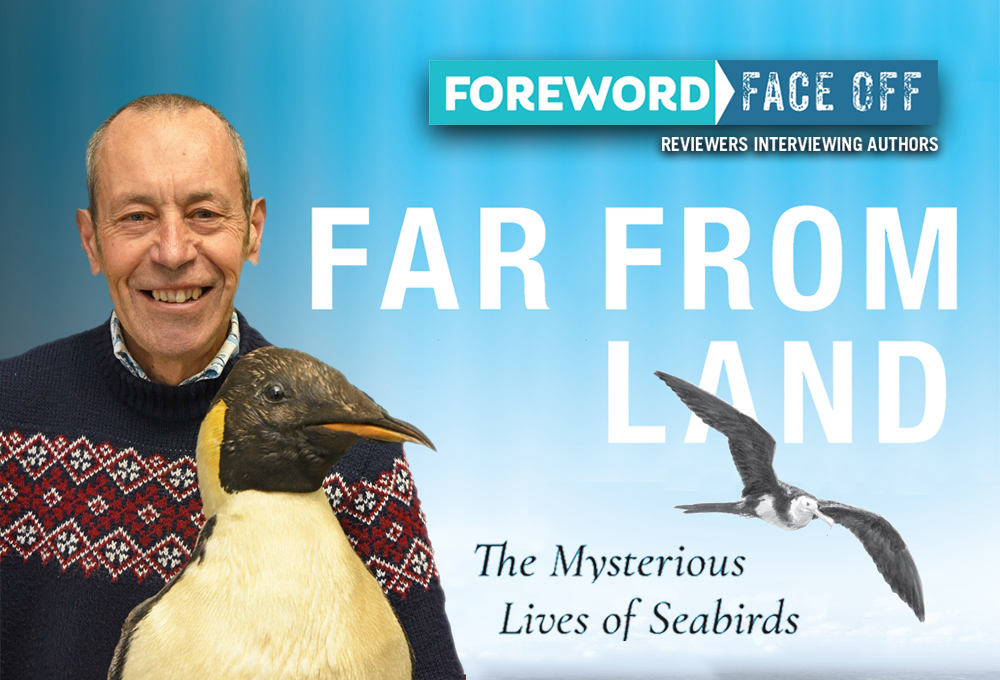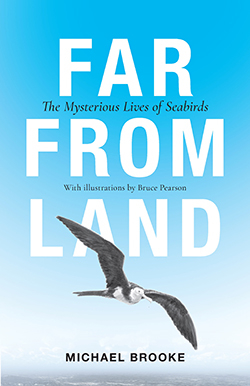Reviewer Touches the Sky with Michael Brooke, Author of Far From Land: The Mysterious Lives of Seabirds.

In what must be a peculiar quirk to my aging process, I find myself growing more and more interested in learning how the natural world works with every passing day. Ocean tides, bobcat hunting habits, how the top boughs of 300-foot-tall sequoias stay hydrated, snake sex, the evolutionary reason yeast developed the ability to create alcohol, the first hours of a hurricane’s formation, why feet stink—these are the places my mind goes when it wanders, and the books that explain such things pile up on my bed stand.

So, when a review copy of Far from Land—detailing the lives of birds that frolic in some of the world’s most inhospitable places—landed on my desk, it was love at first sight. A few days later, while reviewing the book for our March/April issue of Foreword Reviews, I was already formulating some meaty questions for a Face Off conversation with Michael Brooke, ornithologist extraordinaire.
The frigatebirds, puffins, albatrosses, and other seabirds Brooke writes about lead mesmerizing lives. What I’d give to spend a day in their wings.
Look for the week’s Featured Reviews and Special Features down below.
A great many of the stories you tell in Far from Land take place in brutally cold, remote, windswept corners of the world’s oceans—because that’s where the Black-browed Albatrosses, Little Auks, Sooty Shearwaters, Macaroni Penguins, and numerous other seabirds feed. So, let’s begin with a lesson in oceanography. Can you explain why these colder waters are so supportive of sea life, and other, warmer areas less so?
Your generalisation is spot on. Extremely briefly, colder waters tend to support more life because they tend to be richer in nutrients. To elaborate…
In the tropics, warmer less dense water at the surface tends to ‘float’ on top of denser colder water lower down. There is no mixing of the layers. This means that, over time, nutrients disappear from those upper layers as the dead bodies of plants and animals sink to the depths, taking the supply of nutrient building blocks with them. Deprived of essential nutrients, photosynthesis by plankton in the sunlit upper layers of the sea is curtailed. So too is the essential basis for marine food chains.
But wherever the sunlit surface layers are nutrient rich, there is abundant photosynthesis, plankton galore, and marine life aplenty. At high latitudes, that enrichment of the surface layers can happen because winter storms have stirred the sea, much as stirring a cup of coffee will bring the sugar from the bottom of the mug to the surface. But also, importantly, there are parts of the world—the Humboldt Current off Peru is a prime example—where ocean circulation brings cold waters from the depths to the surface. These deep waters are nutrient-rich and hey, presto, life flourishes.
Your career began in the era before miniaturized sensors and sophisticated electronics allowed for the tracking of seabirds. Can you think back to those early days and recollect some of the burning questions you harbored? What were you dying to know?
In the 1970s I completed my PhD on Manx shearwaters. From traditional ringing, we had a fairly good idea of where they went when not breeding in Wales, to the South Atlantic, and, indeed, more precisely to coasts off southern Brazil. But, in truth, I didn’t have the imagination to ask one key question about their journeys. That question is: are there ocean regions where they stop off for a week’s R&R during migration. The answer for Manx shearwaters and indeed many other migratory species turns out to be “yes, there are.” I don’t think we yet understand why some species pause on their journeys, while others complete a journey of many thousands of kilometres without significant interruption.
As a follow up to the previous question, where is the technology heading? What might we possibly know in ten years that barely seems conceivable now?
The technology is certainly getting smaller which obviously means devices can be attached to ever-smaller birds, like terns and storm petrels. But I am not sure their patterns of behaviour will be fundamentally different to those of larger species.
Where we are still at sea, to coin a phrase, is understanding much about the activities of birds in those ‘lost years’ between departing the colony as a fledgling and returning some years later to start courting and, eventually, to integrate into the breeding population. I suspect there will be considerable development of solar-powered devices, that don’t require long-lasting heavy batteries. If these devices can transmit their data from afar, the troublesome need to recapture the bird is avoided. That means we can ask questions about, for example, the extent to which birds visit many colonies in their teenage years before settling to breed at one.
And climate change—warming waters, glacier/pack-ice melt, currents changing course after thousands of years—are seabirds up for the challenges?
I am reasonably optimistic. Just think of the situation at the time of the last Glacial Maximum, around 20,000 years ago. Compared to today, a far larger proportion of the northern hemisphere was covered in ice, and totally unsuitable for seabird nesting. As the ice retreated, the seabirds moved in. Similar movements away from the equator may occur as the climate warms because of human activity.
I guess species giving greatest cause for concern are the ice specialists, the Emperor Penguins nesting on Antarctic ice and, at the other end of the world, northern species such as the Ivory Gull. That species spends a fair amount of time patrolling in the wake of polar bears, scavenging sealy tidbits and bear feces. (Yuk!) If polar bears decline, the gulls may struggle.
All birds are a bit cuckoo, but seabird behavior really is mind boggling. Early in the book, you talk about juvenile Great Frigatebirds and how they often fly continuously for sixty days or so. And some albatrosses leave their place of birth after learning to fly and then wander the seas for up to ten years before returning to breed. Evolutionarily or existentially, why do you think seabirds developed such unique habits? What is it about the sea life that offers such longevity? And speaking of mortality, do any of the birds you study suffer from predation after reaching adulthood?
You ask why seabirds developed such unique habits, and I might answer “Why not?” Natural selection is amazingly adept at producing creatures able to cope with all sorts of environments—think of the wealth of life at hydrothermal vents, the beetles that rely on mist in the Namib desert to satisfy their water needs, and the swarms of seabirds in the Southern Ocean.
In the case of seabirds, it seems that the oceanic life is one that takes several years to master; hence the delayed start to breeding of virtually all seabirds. But, once mastered, it is actually a lifestyle that offers the prospect of long life which, I agree, is slightly counter-intuitive to us landlubbers. Predation at sea probably happens infrequently—skuas take a few birds, and doubtless some seabirds are swallowed by a fish attacking from below. For seabirds in general, coming ashore to breed brings a far greater risk of predation than does daily life at sea.
In your chapter “The Clash,” you describe “seabird interactions with people,” and hazards like power lines, light pollution, and the infuriating fact that jackasses on jet skis purposely plow through flocks of birds on the water. Moreover, non-native animal species like fox, cats, wild goats, rats, and mice do immense damage in seabird nesting areas. Will you give us an update on some of the projects underway to protect the birds from these various threats?
In the past 30-40 years, our ability to rid islands of rats, arguably the most troublesome of the pesky mammals, has grown by leaps and bounds. Around 1980, the maximum size of island for a rat eradication would be 1 sq km. Recently a successful rat eradication has been announced on South Georgia, at 4,000 sq km. A wonderful achievement.
However the damage mice can inflict is now coming into sharper focus. A recent report from Marion Island, in the Roaring Forties southeast of Cape Town, shows how mice can literally scalp young grey-headed albatrosses. The photos are truly gruesome. Presumably the mice attack the scalp because that is the one part of its body that the albatross can’t reach with its bill in order to defend itself.
That said, I show students YouTube clips of mice attacking Tristan albatross chicks on Gough Island in the South Atlantic. Despite weighing maybe 50 times the mouse, the albatross makes minimal effort to defend itself. The mice start nibbling at the bird’s underbelly, and literally chew their way into the body cavity of the living albatross, and eventually kill the chick. Plans are afoot to rid Gough of mice, introduced by sealers around 200 years ago.
The potential for ever-larger mouse projects got a recent boost when the remote Antipodes Islands, 750 km southeast of New Zealand, were declared mouse-free. This was successful culmination of the “Million Dollar Mouse” project, aptly named after the project cost.
All that time on the water, on the shore, on pack ice. You must have seen some incredible interactions between sharks and birds, whales and birds, birds and birds. Would you kindly tell us a couple stories?
Once I was travelling on an inter-island ferry to Rum, in the Hebrides off northwest Scotland. Up ahead, a group of Manx shearwaters and gulls were piling into food, presumably a fish shoal. A Minke whale appeared to share the feast. The skipper slowed the ferry as we passed and, leaning over the ship’s side, I saw the whale literally below me as it swam under the vessel. I could literally have dropped a stone onto it (which I never would have done!).
In the Southern Ocean, near the South Sandwich Islands, I encountered the biggest seas I have ever experienced aboard a 5000-ton research vessel. The swell height was around 17 metres (50+ feet), meaning that, at the bottom of one trough, the crest of the next wave was at the same height as the ship’s bridge. Sea conditions and the 30-degree roll to port and then to starboard prompted the captain to make his way to the bridge to keep an eye on progress. And, all the while, black-bellied storm petrels were skittering in the troughs of the mighty seas as little troubled as a butterfly flitting between bushes on a summer’s day.
Okay, if you were a bird, what species would you be and what remote, beautiful, and oh-so-quiet-and-enchanted little neck of the world would you choose to live?
That’s a question I am frequently asked. I have a habit of wriggling and asking if I am allowed to choose five possibles. One would be a great dusky swift swooping through the plunging curtain of water at the Iguazu Falls, to join my friends clinging to the moist cliff face behind the waterfall.
But I guess you will twist my arm into choosing a seabird. It has to be a Murphy’s petrel. You will probably have guessed from the book that I have a soft spot for these birds, named in 1949 after the illustrious American ornithologist Robert Cushman Murphy. He rashly gave the species the scientific name Pterodroma ultima, a name that was trumped when another Pterodroma species, Barau’s petrel P. baraui, was described in 1963. Murphy’s petrel wasn’t the ultimate but it remains a delightful bird. So docile that you can extract the egg from under an incubating parent, measure the egg and then return it, and receive a soft nibble of thanks from the still-sitting petrel. And all this amid the bluest sea of the South Pacific.
Matt Sutherland
